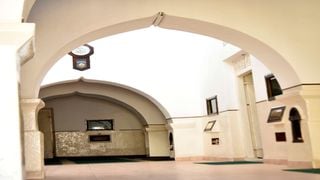
An inside view of Mandhry Mosque in Mombasa’s Old Town in early July 2019.
| File | Nation Media GroupNews
Premium
Mosque where King and Queen will meet with Muslim leaders
What you need to know:
- Mandhry Mosque came to be named after the new settlers who built it and who hailed from the Mandhry clan.
- It is a site that attracts international tourists who come to learn about the history of one of the oldest mosques in Kenya.
When Omani Arabs arrived in Kenya and settled in Old Town, Mombasa, they built houses close together. They also saw a need for a place of worship and decided to build a mosque nearby.
Hence the Mandhry Mosque came to be, named after the new settlers who built it and who hailed from the Mandhry clan. Built in 1570, it is still standing strong to this day.
Located on Sir Mbarak Road in Old Town about 150 meters from the Old Port, Mandhry Mosque has a unique architecture with Omani and Swahili influences.
It is a site that attracts international tourists who come to learn about the history of one of the oldest mosques in Kenya.
The newest visitor to the site will be King Charles III and Queen Camilla, who are expected to have a meeting with Muslim leaders at the mosque on Friday.
Mandhry Mosque was built before Fort Jesus and, 453 years later, the place of worship, which is overseen by the National Museum of Kenya due to its historical and cultural heritage, was refurbished ahead of the visit by the royals from the UK.
From the outside, the mosque, which was previously yellow however, it has now been painted white.
Inside are decorations and intricate patterns harking back to a bygone era but which have stood the test of time. The mosque has five carved doors and four carved windows, many inscriptions, benches, awnings and arched windows.
Items that were used for worship at the monument have been preserved. Holy books, including Qurans, a mimbar (a short flight of steps used as a platform by a preacher in a mosque), Quran inscriptions among other items and decorations remain intact.
Security has also been revamped with policepatrolling the area. The mosque receives more than 200 international tourists in a day.
“When tourists leave Fort Jesus, they visit the mosque. It is part of the city’s tourism circuit.”
“What’s unique about the mosque is that is the oldest. It also has a minaret built by the Mandhry a family from Oman in 1570,” said Mr Alawy Abzein, a historian and chairman of the Swahili Development Initiative.
The mosque has a freshwater well built in 1570. Additionally, the mosque has preserved a Quran manuscript since 1570.
Mr Abzein said the tourist attraction is one of the most well-maintained mosques in Mombasa.
“The design of the mosque included a unique pillar and a kiblah. The mosque has remained unchanged since it was built both inside and outside. There is a gallery — sort of an exhibition area — where historical artefacts are kept,” he added.
He said the King’s visit would create an understanding between Christians and Muslims.
“May it be a harbinger of hope and understanding. Islam is a religion of peace, tolerance, and good neighbourliness,” added Mr Abzein, who is a descendant of the Mandhry family.
He said Mombasa has unique relations with the UK.
At the Makadara grounds, a dome was built in the 1930’s to pay homage to King George VI, who is the grandfather of King Charles III.
In 1962, two pairs of elephant tusks, which adorn the Mapembeni area, were erected in commemoration of Queen Elizabeth II’s visit to Kenya.
The mosque has a minaret, which is only found in three other mosques on the entire coast namely Basheikh, Mbaraki Pillar and Shela. This is unlike all other Swahili mosques, which do not have a similar design.
The minaret symbolised the highness of the Almighty they worshipped.
It was also the place where Imams and Sheikhs made the Adhan (calling the faithful for prayers).
It was a raised area, which enabled the announcements to reach many. In 1990, a madrassa was built on top of the mosque strategically where it could not block the pillar.
According to other historians, during the wars between the Omanis and the Portuguese, the Old Town was burned down on several occasions in an attempt by the Portuguese to forcefully take over the town but the mosque was unscathed.




